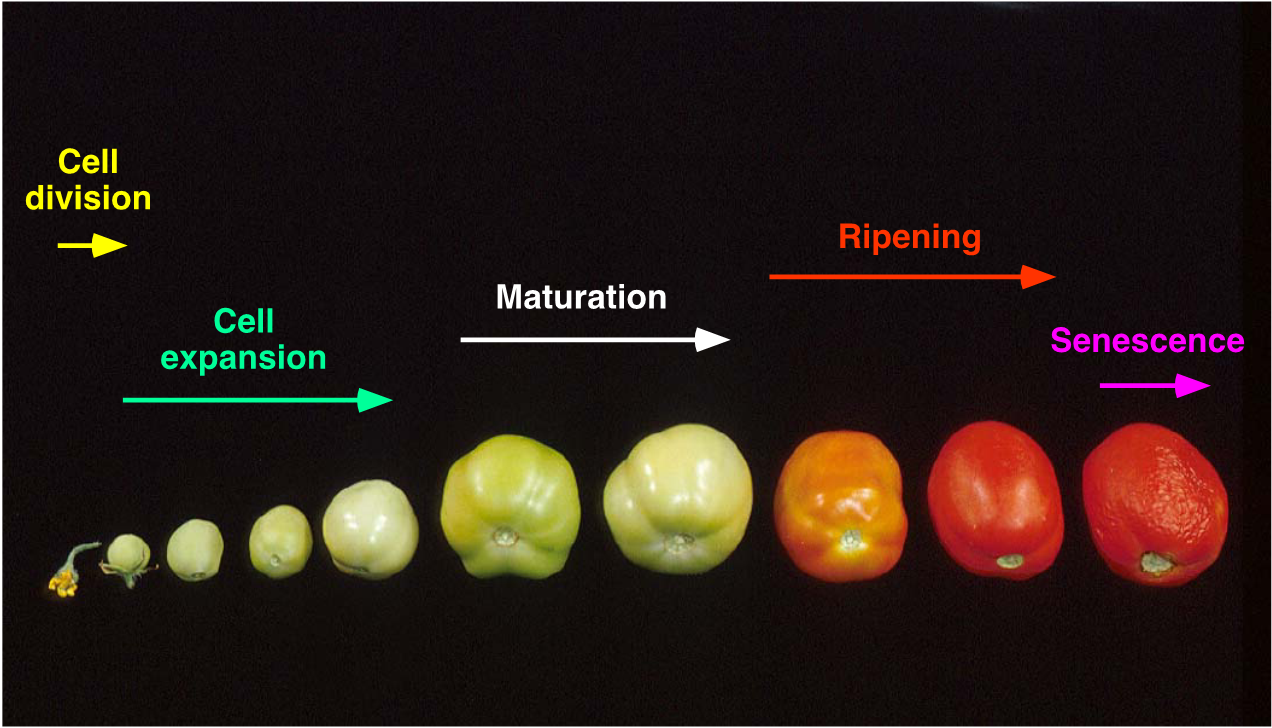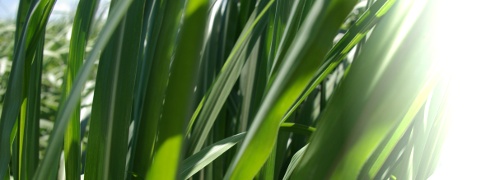Chapter editor: David A. Brummell1
Contributing Authors: Ross G. Atkinson2, David A. Brummell1, Jeremy N. Burdon2, Kevin J. Patterson2, Robert J. Schaffer2. Plant & Food Research, 1Palmerston North; 2Auckland
This Chapter is updated from a previous version written by Rod L. Bieleski, Ian B. Ferguson and Elspeth A. MacRae for Plants in Action 1st Edition.
Picture11.0.png

Fruit development can be divided into a series of stages, as shown here for tomato. Early in development fruit are enlarging rapidly and are small, hard, green and accumulating organic acids. The seeds become mature prior to ripening. During ripening fruit become soft textured, and accumulate soluble sugars, pigments and aroma volatiles. Eventually fruit will become over-ripe, cell structures will deteriorate and the fruit will become susceptible to pathogens. (Photograph courtesy D.A. Brummell)
Fruit evolved as vehicles for production and dispersal of seeds. Humans then imposed further selection pressures to develop products for our use. Such development has accelerated over the past century. Interestingly, our concept of a fruit as a sweet and fleshy object for eating is really quite recent in evolutionary terms.
Despite modifications and exaggerations of fruit structures due to human selection, and with a few seedless exceptions such as banana and sultana grapes, fruit growth is largely dictated by seed development. Processes underlying those influences are considered here, followed by an account of postharvest changes.
Postharvest technology is also a human device to serve human needs, and includes everything that happens to crops between harvest and human utilisation. However, preharvest events affect subsequent postharvest behaviour. Genetic background is particularly important, in part determining crop response to growth and storage environments. Postharvest techniques can be simple and slight, as in grain stores, or highly developed, as in controlled atmosphere storage of fresh produce.
In every instance, some key concepts apply. In particular, potential quality of fresh commodities is irretrievably fixed by harvest time, with no further opportunities to manipulate their basic properties. After harvest, storage time may be as short as the few minutes taken for immediate consumption, or extremely prolonged as with years of seed bank storage. Most research discussed here is concerned with storage periods of 2–25 weeks. Handling over this period has a profound effect on final usefulness because a crop is still alive throughout this process and vulnerable to adverse conditions. Postharvest physiology is therefore of particular importance to countries such as Australia and New Zealand, which ship a large portion of their crops to distant markets. Accordingly, green kiwifruit (Actinidia deliciosa) and yellow kiwifruit (Actinidia chinensis) are used here as examples where principles of postharvest research have been applied successfully in establishing a new international crop on a stable and permanent basis.
Wild fruit often contain components that make them unattractive to potential consumers until they are ready to be dispersed. These commonly include calcium oxalate crystals (raphides), bitter flavours and astringent tastes. However, humankind has adapted fruit for personal use by applying intense selection pressure to remove unpleasant components and enhance desired features. These include appealing flavour with well-developed aroma volatiles and sweetness, bright colour, pleasant texture and high food value. As early as the seventeenth century, Gerard recorded that ‘some peares are sweet, divers fat and unctuous, others soure, and most are harsh, especially the wilde peares’ (John Gerard, “Herball or General Historie of Plants”, 1633). Nowadays, all European and Asian cultivars are sweet with greatly reduced acidity and tannin content compared with their various wild parents. Persimmons provide another example where an originally astringent fruit has given rise to a non-astringent form.
During the twentieth century, additional selection pressures have been applied to temperate fruit species in a drive for cultivars that are well suited to postharvest handling and storage. This has not been true for most tropical fruit, which have had less selection for such characteristics and which still present challenging problems for postharvest researchers and breeders.
The history of kiwifruit shows some of the steps that have led to the development of a successful commercial fruit. It was a wild species until 1900, when domestication began. A major commercially valuable green cultivar, ‘Hayward’, was selected around 1930. This event was followed by progressive development of techniques for cultivation, handling and marketing — all required to make a new fruit commercially successful. Further development of the yellow or golden kiwifruit cultivar ‘Hort16A’ in the late 1990s added the unique combination of a highly flavoured fruit with a vibrant yellow flesh. Several features of kiwifruit physiology made it amenable to commercialisation, namely (1) unusual and unique flavours combined with good nutritional value, (2) retention of chlorophyll so that inside tissues remain bright green when ripe (‘Hayward’), (3) a long and manageable ripening period resulting in a long harvest season where fruit can be picked in a mature but firm condition, and (4), especially important, kiwifruit tolerate lengthy low-temperature storage without subsequent shelf life being compromised.
